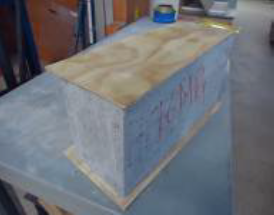1 MSc, PhD student, Federal University of São Carlos, Civil Engineering Dept, ernestofortes@hotmail.com
2 Undergrad Student, Federal University of São Carlos, Civil Engineering Dept, dorinhapp@hotmail.com
3 PhD, Professor, Federal University of São Carlos, Civil Engineering Dept, parsekian@ufscar.br
4 MSc, Brazilian Portland Cement Association, claudio.silva@abcp.org.br
5 PhD, Professor, Federal University of São Carlos, Statistics Dept, polpo@ufscar.br
6 PhD, Professor, Federal University of São Carlos, Statistics Dept, dtmd@ufscar.br
ABSTRACT
Compression strength is the most common quality control test of concrete blocks. Before testing, a flat and perpendicular surface on each face of the block is necessary to allow a reasonable low dispersion of results. Cement paste is the most commonly used capping material in local Brazilian tests, where recently the permission of grinding instead of capping was added to local codes.
This work is aimed to experimentally evaluate the possibility of using dry materials – such as hardboard, plywood and fibreboard, with thickness of 2.5 mm, 3 mm, and 12 mm respectively – on capping, to replace cement paste. The tests have also included the use of grinding. A total of 90 blocks were tested for every type of capping, divided into three nominal resistances of blocks (4 MPa (B4), 8 MPa (B8) and 16 MPa (B8), gross area). Data and results were analyzed, and it was possible to notice the influence of capping on blocks strength.
A statistical analysis was carried out to evaluate the influence of each capping on the compressive strength of blocks.
The block tests’ results have indicated low variation coefficient for each kind of capping. In general, results of characteristic values are similar, except for cases of low resistance blocks (B4) with fiberboard and plywood – whose differences exceed 10% when compared to cement paste. The use of dry materials for capping can ease of use the test procedure with great reduction time and laboratory space (in the case of capping with cement) when compared to cement paste and grinding.
KEYWORDS: capping, concrete block, compressive strength
105.pdf



